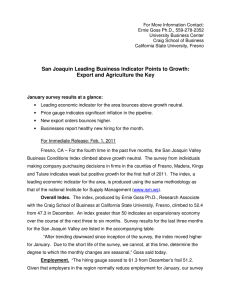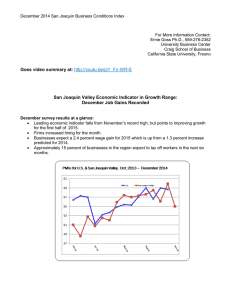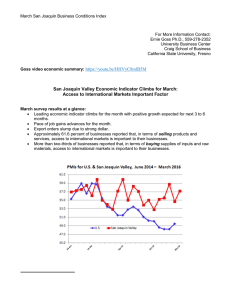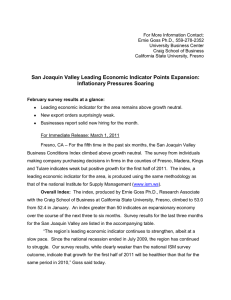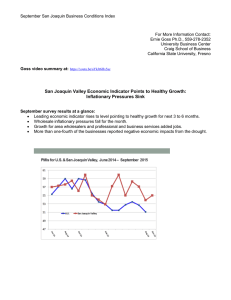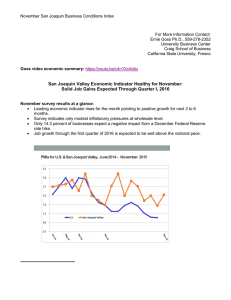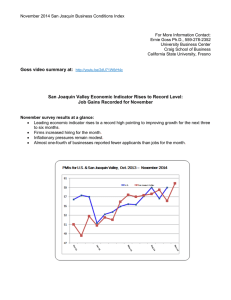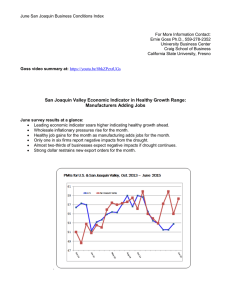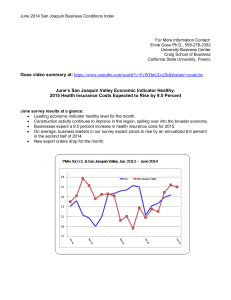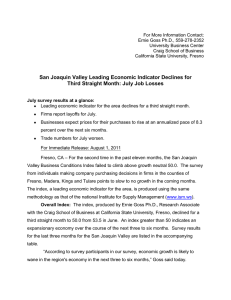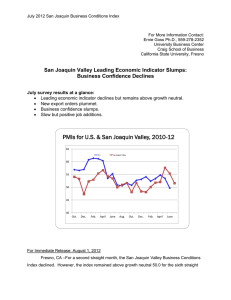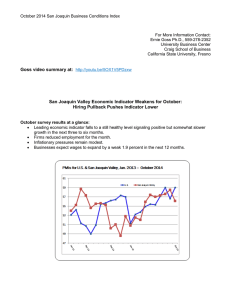For More Information Contact: Ernie Goss Ph.D., 559-278-2352 University Business Center
advertisement
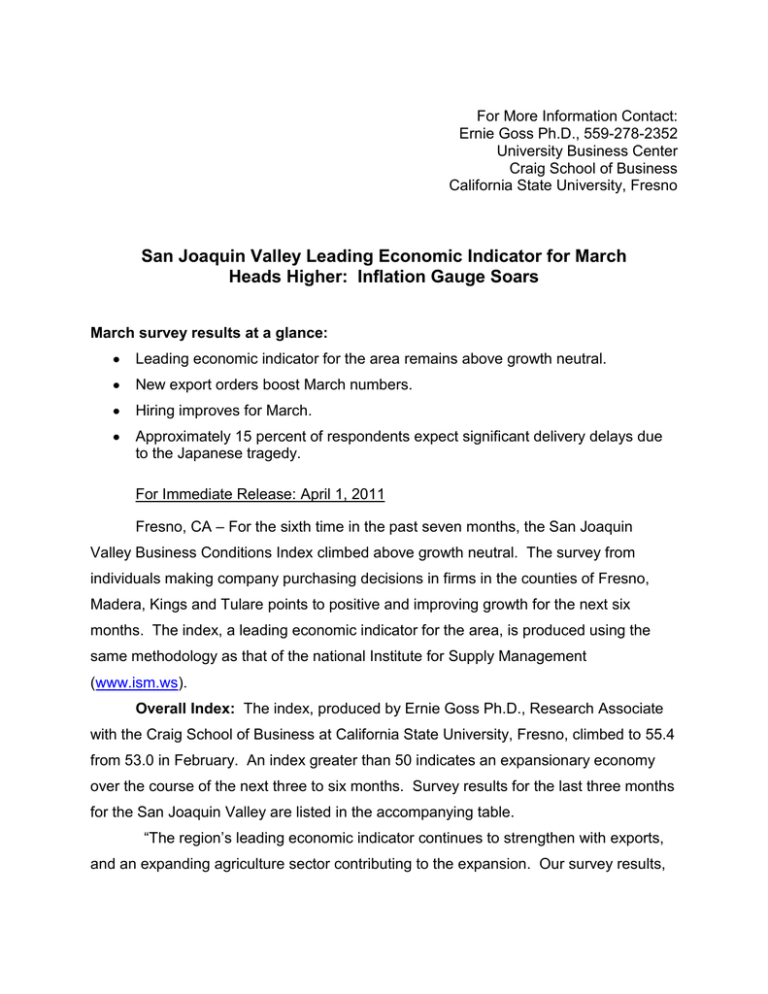
For More Information Contact: Ernie Goss Ph.D., 559-278-2352 University Business Center Craig School of Business California State University, Fresno San Joaquin Valley Leading Economic Indicator for March Heads Higher: Inflation Gauge Soars March survey results at a glance: Leading economic indicator for the area remains above growth neutral. New export orders boost March numbers. Hiring improves for March. Approximately 15 percent of respondents expect significant delivery delays due to the Japanese tragedy. For Immediate Release: April 1, 2011 Fresno, CA – For the sixth time in the past seven months, the San Joaquin Valley Business Conditions Index climbed above growth neutral. The survey from individuals making company purchasing decisions in firms in the counties of Fresno, Madera, Kings and Tulare points to positive and improving growth for the next six months. The index, a leading economic indicator for the area, is produced using the same methodology as that of the national Institute for Supply Management (www.ism.ws). Overall Index: The index, produced by Ernie Goss Ph.D., Research Associate with the Craig School of Business at California State University, Fresno, climbed to 55.4 from 53.0 in February. An index greater than 50 indicates an expansionary economy over the course of the next three to six months. Survey results for the last three months for the San Joaquin Valley are listed in the accompanying table. “The region’s leading economic indicator continues to strengthen with exports, and an expanding agriculture sector contributing to the expansion. Our survey results, San Joaquin Business Conditions Index – p. 2 of 4 while clearly weaker than the national ISM survey outcome, indicate that each month growth prospects are improving,” Goss said today. Employment: “The hiring gauge slipped to 54.8 from February’s 56.4. “Even with expanding jobs, it will take many months for the area to recapture jobs lost during the recession. From the beginning of the recession in December 2007 until March of last year the area lost more almost 25,000 jobs. Over the past year, the area has recovered less than 2,000 of those lost jobs. Our surveys over the past several months indicate that the region will add another 3,000 by the end of the first quarter of 2012 leaving the region down almost 20,000 jobs, or 7 percent, since beginning of the recession,” reported Goss. Inflation: The prices-paid index, which tracks the cost of raw materials and supplies, rose to an inflationary 84.2 from 81.8 in February. “We continue to record unacceptably high inflationary pressures at the wholesale level. The upward pressures in prices will be further exacerbated by disruptions of supplies and products from Japan,” said Goss. “Additionally, the Federal Reserve’s record low short-term interest rate policy and the Fed’s policy of buying long-term U.S. Treasury debt, termed quantitative easing 2 (QE2), will continue to contribute to higher inflationary pressures. Over the past three months, U.S. wholesale prices have advanced at an annualized pace of more than 15 percent. Surveys of supply managers, both in our region and nationally, indicate that this elevated pace will continue at least through the summer of this year,” Goss said. Business Confidence: Looking ahead six months, economic optimism, captured by the March business confidence index, declined to a still strong 63.8 from 67.6 in February. “Despite higher commodity prices, unacceptably elevated unemployment rates, and Japanese supply disruptions, firms remain upbeat in their economic outlook,” said Goss. Trade: New export orders for March were healthy. The March new export orders reading climbed to 56.6 from 49.9 in February. The area’s import index dipped to 64.6 from 67.2 in February. “Despite all of the international turmoil and uncertainty, businesses continue to expand both sales and purchases abroad. Aided by a cheap San Joaquin Business Conditions Index – p. 3 of 4 dollar making U.S. goods more competitively priced abroad and an expanding global economy, we are tracking improving sales abroad,” said Goss. Inventories: The inventory index, which tracks the change in the inventory of raw materials and supplies, climbed to 53.8 from 51.8 in February. “As a result of improving sales outlook, firms in the area continue to add to inventory levels,” said Goss. This month supply managers were asked how they expected the Japanese tragedy to affect their purchases of supplies and inputs. Approximately three-fourths of respondents expected little or no impact on the price of purchases while only 6.5 percent anticipated price increases of more than 10 percent resulting from the earthquake and tsunami. In terms of deliveries, approximately 15 percent expect significant delays in obtaining supplies while 63 percent anticipate little or no impact on delivery speed stemming from the Japanese disaster. The remaining supply managers anticipate only minor delays. Other components: Other components of the March Business Conditions Index were new orders at 56.3, up from 51.9 in February; production or sales at 59.3, up from 55.8; and delivery lead time at 52.8, up from 49.1 in February. The Craig School of Business uses the same methodology as a national survey by the Institute for Supply Management, formerly the Purchasing Management Association, which has formally surveyed its membership since 1931 to gauge business conditions (www.ism.ws). The overall index, referred to as the Business Conditions Index, ranges between 0 and 100. The overall index is a mathematical average of indices for new orders, production or sales, employment, inventories and delivery lead time. Table 1 details survey results for the last three months. April survey results will be released on the first business day of next month, May 2. San Joaquin Business Conditions Index – p. 4 of 4 Table 1: Overall and component indices for last 3 months (above 50.0 indicates expansion) Leading economic indicator New orders Production or sales Employment Inventories Delivery lead time Prices paid Imports Export orders Business confidence San Joaquin Valley January 2011 February 2011 52.4 53.0 55.1 51.9 60.3 55.8 61.3 56.4 45.0 51.8 40.6 49.1 72.7 81.8 67.7 67.2 52.9 49.9 73.8 67.6 March 2011 55.4 56.3 59.3 54.8 53.8 52.8 84.2 64.6 56.6 63.8 Craig School of Business: http://www.craig.csufresno.edu/ Follow Goss: Twitter at http://twitter.com/erniegoss or www.ernestgoss.com
